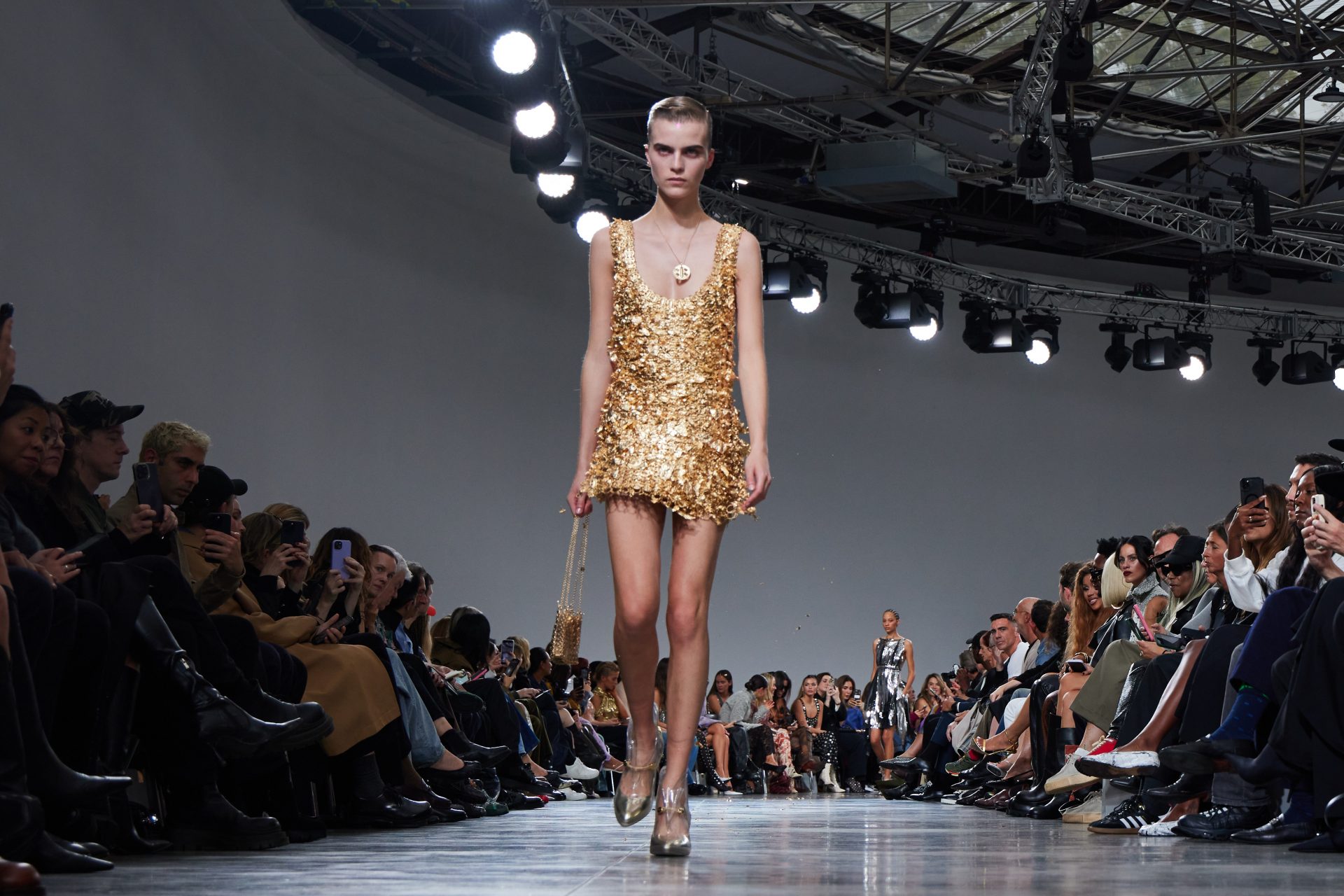The most controversial art in history
This work could be summed up in a few key words: a banana, neither too little nor too ripe, a piece of duct tape, and Art Basel Miami. Maurizio Cattelan is known for his subversive installations. In December 2019, after he hadn't exhibited anything at a contemporary art fair for 15 years, he presented 'Comedian,' this banana hanging on the wall. In addition to the apparent simplicity of this work, its price also animated the critics, since it sold for $120,000.
Defenders of the work say that we should not focus on the aesthetics of the taped banana. Instead, it must be placed in its context. Four copies of this installation exist and have been sold. They all come with a certificate of authenticity and instructions, drawn up by the artist, specifying how the fruit should be replaced once every ten days.
Between March 2020 and 2022, Trafalgar Square in London hosted an unconventional artwork. Made by Heather Phillipson, it depicts a huge mountain of whipped cream topped with a giant cherry and dotted with a fly and a drone. According to the artist, 'The End' symbolized "arrogance and impending collapse." The multimedia work included videos of its surroundings, shot by the drone and then broadcast on a dedicated website.
Courbet, seen here in his self-portrait 'Desperate,' produced a painting that was considered outrageous in the modest and moralist 19th century. In fact, until 1995, only a few people had been able to see the work in person. It had only been exhibited twice: in New York in 1988 and in Oran in 1992. What's on the painting? A woman without clothes, depicted from her private parts upwards. Courbet made the work as an homage to women - both as lovers and mothers - but many people didn't see it that way. The painting now hangs in the Musée d'Orsay in Paris.
For this art installation, Tracey Emin was inspired by her own life as a woman with a deep depression. She stayed in bed for several days after a breakup and did not eat or drink anything other than alcohol. Over time, waste and disorder accumulated around the soiled bed. She put a replica of that bed in the exhibition hall. To critics who said that anyone could 'create' an unmade bed, she replied, "Well, they didn't, did they? No one had ever done that before."
In this black and white photo from 1980, the contrast is marked between the costume of the man posing and the flesh of his hands. Some say the person on the photo is the artist's boyfriend, but it is generally considered a self-portrait. However, American senators and conservatives believe that this image represents an example of "degenerate art." The photo was sold in 2015 for no less than 478,000 dollars.
Inaugurated on September 18, 2021, in the presence of the French president Emmanuel Macron and Paris mayor Anne Hidalgo, the work of Christo and Jeanne-Claude sparked many debates about contemporary art. The world-famous Arc de Triomphe had been wrapped in 25,000 square meters of recyclable polypropylene fabric, bluish silver in color, and held together by 7,000 meters of red rope. Although Christo had died in 2020, the artwork was still displayed as a way to pay tribute to him.
The supposed "tree" of the American artist had been erected on Place Vendôme in Paris in 2014. Its shape was suggestive, to say the least, and the work quickly became the subject of controversy. After being vandalized and attacked, the Tree was removed after a week. In a sense, we can say that the work achieved its goal: subversion.
This work appears to represent a carnal relationship between a man and an animal. It was placed right in the middle of the Centre Pompidou in Paris, after the Louvre had refused it. The work is 12 meters (39'9 ft) high and made out of red Lego blocks.
This young boy without clothes, immaculately white, holds a frog in his hand with a sadistic air. Installed in front of the Punta Della Dogana in Venice, at the entrance to the Grand Canal, the work was not at all to the taste of some Venetians. They preferred the more classic 19th-century cast iron lamppost which the sculpture had replaced. Despite pleas from contemporary art lovers, the city ended up removing the statue.
For a 2010 personal exhibition at the Palazzo Reale in Milan, Maurizio Cattelan had 'LOVE' installed: a big white, 11-meter (36 ft) marble hand with the middle finger up. The meaning of the work? L = liberta (freedom); O = odio (hate); V = vendetta (revenge); E = eternita (eternity). The finger faces the Milan Stock Exchange. Of course, many people were offended by it. In response, the artist said he would give the sculpture to the city if its location would become permanent.
'Bouquet of Tulips' was a gift from Jeff Koons to the city of Paris in 2016. He justified it as "a gesture of friendship between the American and the French people" after the terrorist attacks of 2015 and 2016. This sculpture, which represents a hand holding multicolored tulips, is 10 meters high (32,80 ft), 8 wide (26,24 ft), and weighs 27 tons without its base. It is supposed to represent "the act of offering." However, in 2017, local artists launched a petition that said "No to Jeff Koons' bouquet of tulips in Paris," denouncing the "excess" of the project.
"The choice of the work, and especially of its location, with no relation to the tragic events involved in the location, appear surprising to say the least, if not opportunistic, and even cynical," local artists write in the newspaper Liberation. According to them, Jeff Koons has "become the emblem of an industrial, spectacular and speculative art" and "his work hypes luxury multinationals."
Olafur Eliasson tends to engage with the topic of Man and his environment. For this artwork, he moved blocks of ice from Greenland and exhibited them in Copenhagen, Paris, and London. Irremediably, the work self-destructed before the eyes of the spectators. Eliasson may have meant this work as a warning about climate change, but its production - transporting 100 tonnes of ice, extracted from the icebergs and moved around by plane - was contradictory.
In 2014, Surrey NanoSystems, a British company specializing in nanotechnology, created the blackest black in the world, 'Vantablack.' Composed of carbon nanotubes arranged vertically and "tight against each other like trees in a forest", it is a color black with an absorption coefficient of 99.965%. In 2016, Anish Kapoor obtained the exclusive right to use this material for his art. His colleagues were annoyed and mounted the campaign #ShareTheBlack. In 2019, artist Stuart Semple managed to create a deep black called "Black 3.0," which then became accessible to all.
Installed in the gardens of the Palace of Versailles in 2015, the work provoked extremely violent reactions. The large steel trunk, 60 meters (196,85 ft) long and 8 meters (26,24 ft) high, represents a female organ. Soon after its installation, the work was vandalized. A few months later, it was covered with hateful and anti-Semitic writings. The artist decided to leave them there because they were now 'part of the work.' The third time the work was vandalized, it was with the inscription: "Respect art as you believe in God."
Inaugurated on Valentine's Day 2019 and as part of the artistic program of the T3 tramway, this big red heart of 9 meters (29,5276 ft) high is made up of 3,800 earthenware tiles. At night, thousands of LEDs illuminate it. The problem? The work was placed in Porte de Clignancourt, one of the poorest districts of Paris. It cost €650,000 ($727,350), financed by public money, of which €40,000 ($44,760) was given to the artist.
Allen Jones is one of the first English pop artists. Fascinated by women with long legs, perched on high heels, and by the subversive culture of fetishism, his works are both committed and disturbing. In 1969 he displayed the work we partly see in this photo: Coat Rack, Chair and Table. He claimed to be a feminist and said he was inspired by the sexualization of women's clothing in the 1960s. Still, each of his exhibitions in the 70s was met with feminist demonstrations.
Produced by Brazilian artist Juliana Notari in January 2021, the work has come under attack for explicitly depicting the female reproductive system. Since the rise of Bolsonaro as its leader in 2018, the country has been socially and politically torn. Notari's opponents say that 'Diva' is indecent and ugly.
Photo: juliana_notari / Instagram
It's not just what's depicted that drew criticism, however. 'Diva' was built on the land of a former sugar plantation and was put in its place by a black workforce, as can be seen in the image. Critics on social media argued that the place and circumstances of 'Diva' were tasteless and insensitive.
Image: juliana_notari / Instagram
Cattelan is the king of controversy. This wax statue, kneeling in a prayer position, dressed in a gray suit, is only 101 centimeters (39,76 inches) high - the size of a child. When you approach it and have a closer look, you see that the character is Adolf Hitler. Critics have argued that it's tasteless to represent the dictator as a small figure with a "childlike purity."
Another controversy regarding the sculpture concerns its location. It stood in the private courtyard of a building in the Warsaw ghetto, where half a million Polish Jews were isolated and then deported during World War II. The statue stood only a few hundred meters from the Warsaw Ghetto Uprising Memorial. After lots of criticism, it was removed because it would be "a senseless provocation which insults the memory of the Jewish victims of the Nazis."
Manet shocked people when he presented them his work 'Luncheon on the Grass' in 1863. It depicted a woman without clothes amidst dressed men. She looks straight at the viewer, as a provocation, indicating that she is probably a 'lady of the night.' After much discussion, the painting was finally exhibited in the Salon des Refusés in 1863. Today, the work is one of the best known in the world.
Another work by Manet, who felt he did nothing wrong by continuing the tradition of Titian, Vélasquez, or Goya who painted women without clothes. However, the other painters hid their depictions under the prism of allegory, while Manet made his message very clear. The title of this work, 'Olympia,' is a reference to a nickname for sex workers at the time.
Degas is well known for his depictions of dancers. Fascinated and committed to making images as close to reality as possible, he built a realistic ballerina here, with a real tutu and dancing shoes on a wax statue. Critics said the girl depicted was very young and that Degas had a dirty mind when he made it.
Marcel Duchamp redefined the concept of a work of art. He looked for the boundary between art and common objects. An example is this work, called Fountain. He signed it as 'R. Mutt,' a reference to an 'idiot' or 'clown.'
Duchamp sent the object to the brand new Society of Independent Artists of New York, founded in 1916 and on the verge of holding its first Salon. As they didn't recognize the name 'Mutt' and believed it was a joke, the jury refused to exhibit the urinal. Only in 1950, Duchamp began to claim the ownership of his Fountain.
Piero Manzoni is largely inspired by ready-made artists such as Marcel Duchamp. In 1961, he created and then sold 90 numbered and signed tin cans, which contained… his excrement. The public had no choice but to take the artist's word that the contents of the cans were really of his making. The work was meant as a satire of the art market, where any creation made by an A-listed artist had a very good chance of selling quickly. Since then, several boxes have been opened and the mystery has been solved: they do really contain excrement…
In this work, the artist tackles the sacrosanct image of the pope. At the time when it was made, John Paul II, whose features we recognize in this wax statue, was still alive. The work leaves no spectator indifferent as the Holy Man is extremely realistic and life-size.








































